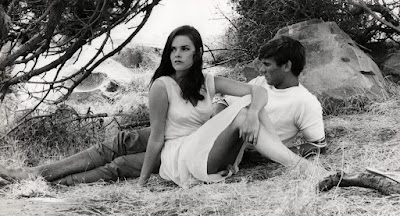

Time in Summer (Ludwik Dutkiewicz, 1968) prod. Arkaba Films, dp Ian Davidson, ed. G. Turney-Smith, music Richard Meale; Christina O'Brien, Rory Hume, Peter Ross, Andrena Gwynn-Jones, Gillian Young, Lorraine Irving, Neal Hume, Andrea Adams, Anne Holzner, Ahla de Lazareff, Peter Perry, Susan Tipping, Bill Kay; SA; art film, 64 min.
Pike & Cooper:
This South Australian feature was described by its director as 'a note-book of experiences and thoughts recorded during an Australian summer'. Two stories are interwoven: a young woman experiences her first love affair, while her brother is nearly killed in a car crash and lies semi-conscious with his mind hovering over the events leading up to the crash.
The film was a climax in the career of the photographer, Ian Davidson. Displaying firm control over a wide range of optical effects, he created a timeless, dream-like setting for the fragmented action, although the fragile poetry of his images was undercut somewhat by stilted dialogue and clumsy direction of the cast. The film was screened at the Berlin Film Festival in 1968, but the commercial trade in Australia showed no interest. A world premiere season was held on 17 March 1968 at a university theatre during the Adelaide Festival of Arts.
The director, Ludwik Dutkiewicz, was born in 1921 and came to Australia from Poland after the war. He established himself as an abstract painter of some note, and while working in theatre in Adelaide he met Ian Davidson. They first collaborated on Transfiguration (1964), a four-minute exploration of Eisenstein's montage principles, with images edited schematically to the music of Bruckner. This experimental short won many awards and led to a more elaborate investigation of the 'metaphysical implications' of sequence structure and image composition in Time In Summer.
Ian Davidson had worked during the 1950s as a documentary and news photographer, and had collaborated with Stan Ostoja-Kotkowski in a series of short abstract films, including The Quest of Time (1955). He later worked again with Ostoja-Kotkowski on a lavish multi-media presentation, The Oldest Continent: Time Riders (1970), combining electronic sound and music effects with poetry readings and ballet. After Time In Summer he attempted to set up further productions with Dutkiewicz, but they failed to raise the necessary finance.
David Heslin:
Midway through Time in Summer (Ludwik Dutkiewicz, 1968), a ballerina dances alone on stage to a thunderous classical piano piece. She is not one of the numerous women we have previously seen in the film, and even here is barely visible; we merely glimpse her figure within a flickering iris shot, which is superimposed over an image of trees reflected in rippling water. It is as if she has been transported from a silent movie, and in a different realm entirely from the male audience member whose attentive gaze we see in close-up. ...
Heslin, David 2022, 'Mixed up with other people's dreams: the tangled webs of Time in Summer', Metro.
Garry Gillard | New: 9 September, 2022 | Now: 9 September, 2022